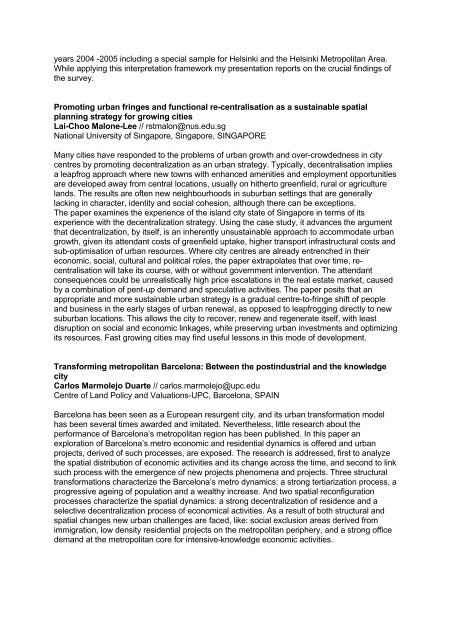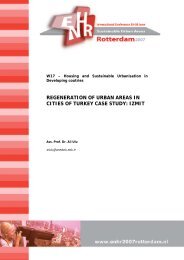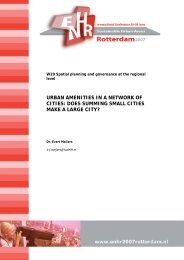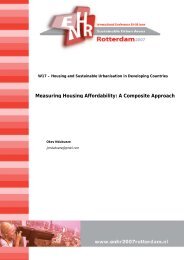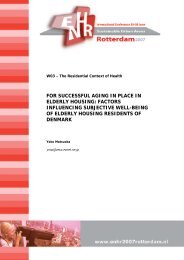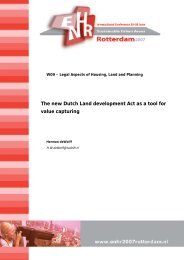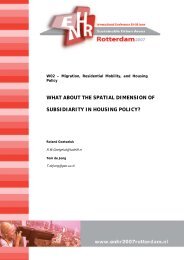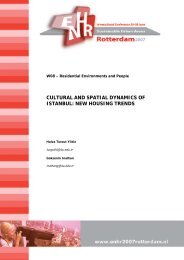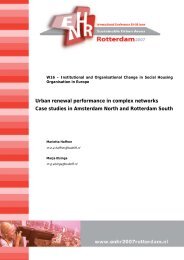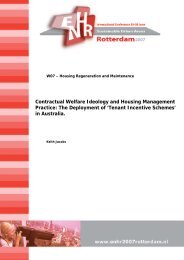Download abstracts - ENHR 2007 Rotterdam
Download abstracts - ENHR 2007 Rotterdam
Download abstracts - ENHR 2007 Rotterdam
Create successful ePaper yourself
Turn your PDF publications into a flip-book with our unique Google optimized e-Paper software.
years 2004 -2005 including a special sample for Helsinki and the Helsinki Metropolitan Area.<br />
While applying this interpretation framework my presentation reports on the crucial findings of<br />
the survey.<br />
Promoting urban fringes and functional re-centralisation as a sustainable spatial<br />
planning strategy for growing cities<br />
Lai-Choo Malone-Lee // rstmalon@nus.edu.sg<br />
National University of Singapore, Singapore, SINGAPORE<br />
Many cities have responded to the problems of urban growth and over-crowdedness in city<br />
centres by promoting decentralization as an urban strategy. Typically, decentralisation implies<br />
a leapfrog approach where new towns with enhanced amenities and employment opportunities<br />
are developed away from central locations, usually on hitherto greenfield, rural or agriculture<br />
lands. The results are often new neighbourhoods in suburban settings that are generally<br />
lacking in character, identity and social cohesion, although there can be exceptions.<br />
The paper examines the experience of the island city state of Singapore in terms of its<br />
experience with the decentralization strategy. Using the case study, it advances the argument<br />
that decentralization, by itself, is an inherently unsustainable approach to accommodate urban<br />
growth, given its attendant costs of greenfield uptake, higher transport infrastructural costs and<br />
sub-optimisation of urban resources. Where city centres are already entrenched in their<br />
economic, social, cultural and political roles, the paper extrapolates that over time, recentralisation<br />
will take its course, with or without government intervention. The attendant<br />
consequences could be unrealistically high price escalations in the real estate market, caused<br />
by a combination of pent-up demand and speculative activities. The paper posits that an<br />
appropriate and more sustainable urban strategy is a gradual centre-to-fringe shift of people<br />
and business in the early stages of urban renewal, as opposed to leapfrogging directly to new<br />
suburban locations. This allows the city to recover, renew and regenerate itself, with least<br />
disruption on social and economic linkages, while preserving urban investments and optimizing<br />
its resources. Fast growing cities may find useful lessons in this mode of development.<br />
Transforming metropolitan Barcelona: Between the postindustrial and the knowledge<br />
city<br />
Carlos Marmolejo Duarte // carlos.marmolejo@upc.edu<br />
Centre of Land Policy and Valuations-UPC, Barcelona, SPAIN<br />
Barcelona has been seen as a European resurgent city, and its urban transformation model<br />
has been several times awarded and imitated. Nevertheless, little research about the<br />
performance of Barcelona’s metropolitan region has been published. In this paper an<br />
exploration of Barcelona’s metro economic and residential dynamics is offered and urban<br />
projects, derived of such processes, are exposed. The research is addressed, first to analyze<br />
the spatial distribution of economic activities and its change across the time, and second to link<br />
such process with the emergence of new projects phenomena and projects. Three structural<br />
transformations characterize the Barcelona’s metro dynamics: a strong tertiarization process, a<br />
progressive ageing of population and a wealthy increase. And two spatial reconfiguration<br />
processes characterize the spatial dynamics: a strong decentralization of residence and a<br />
selective decentralization process of economical activities. As a result of both structural and<br />
spatial changes new urban challenges are faced, like: social exclusion areas derived from<br />
immigration, low density residential projects on the metropolitan periphery, and a strong office<br />
demand at the metropolitan core for intensive-knowledge economic activities.


